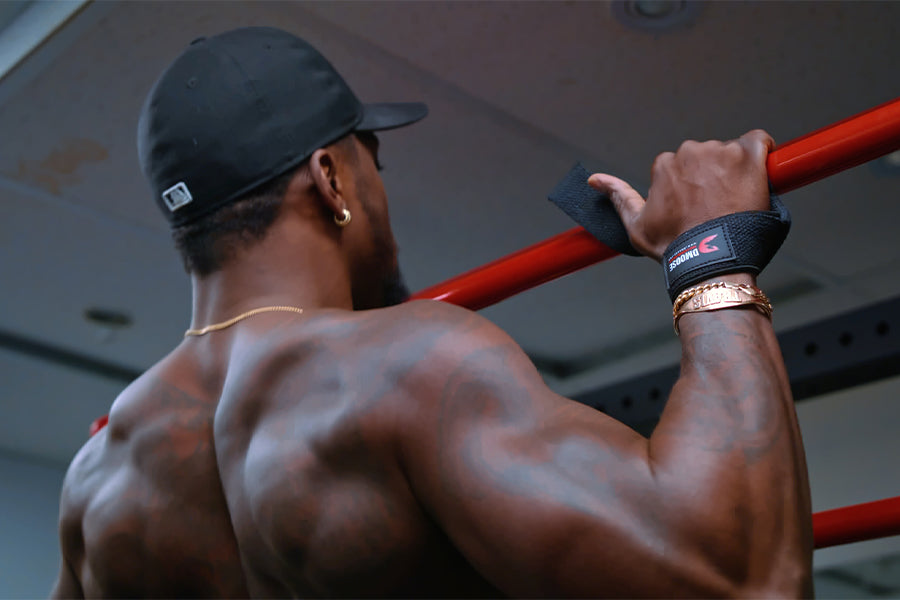Have you ever noticed how people hold the barbells and then take a few seconds before they lift them? Have you seen them dangling a little?
This dance move is not just because the weights are heavy but also because their wrists take time to adjust and get ready to lift.
Many times, people end up dropping the heavyweights on the floor instead of placing them down gently; this is also due to the weight of the barbells and their wrists giving upon them.
But I am certain that you would want to skip all of these uncomfortable situations and do not want to end up getting injured.
Therefore, in this article, we will be introducing you to lifting straps, the ultimate gym gear that will help you lift heavy weights easily, reduce the pressure on your wrists and avoid any kinds of injuries as well.
What are Lifting Straps?

Lifting straps are the ultimate new gym gear made with heavy-duty cotton webbing and neoprene paddings to help you lift heavy weights without injuring your wrists.
When wrapped around your wrist from one end and on the barbell or dumbbell from the other, these lifting straps help you lift heavy weights and enjoy powerlifting exercises such as deadlifts, squats, bench press, etc.
Lifting Straps Vs. Lifting Hooks

Lifting straps and lifting hooks seem to be offering the same purpose but are very different from each other, not just in their shapes but also in their functionality and usage.
Lifting straps are an ideal gym gear to be used because they offer versatility to the users. Whether you use them for heavy weight lifting, chin-ups, or barbell rows, gym straps can help you enjoy shoulders, traps, and arms workouts.
Whereas lifting hooks are easier to use and set up, they are limited in their usage. The hooks do not fit with every dumbbell and barbell, and you cannot use them for other exercises except for lifting because the hooks will get detached.
It's not just the versatility offered by the powerlifting straps but the fact that they are cheaper, efficient, mimic better wrist action and allow you to use your wrists’ strength and stabilization muscles when training, so you don't end up depending on anything.
Even though the straps are a great option for strength training and weight lifting, the lifting hooks are also a great buy. They offer you greater wrist support and allow you to enjoy isolated workouts leading to muscle hypertrophy.
Lifting straps and lifting hooks both come with their own sets of advantages and disadvantages like any other gym gear. It's up to you how you choose to use them because that's all that will make the difference, for their utility and efficiency.
Benefits of Using Lifting Straps
Here are a few more benefits that will surely convince you to buy the perfect straps:
1. Enhanced Grip Action
When it comes to lifting heavy weights, it's not the shoulder or arm strength that will give up on you, but your grip strength definitely will.
Using the workout straps will be your best bet to make sure you lift weights without dropping them on the floor or your feet.
When wrapped around the wrist and weight bars, the gym straps release the pressure on the wrist and allow you to grip the bars easily for longer durations, leading to greater muscle growth.
Related Article: How to Fix the Issue of Losing Your Grip During Lifting
2. Increased Wrist Support
Among the many injuries weight lifters suffer, a common injury is dislocating the wrists' muscles. This spraining and straining of wrist muscles happen because of poor grip strength and incorrect angle.
Using lifting straps provides adequate wrist support and ensures that your wrist is aligned with the weighted bars properly, so you don't end up hurting your muscles or dropping the bars on your feet.
Related Article: 5 Reasons Why Wrist Training is Important for Bodybuilders
3. A Comfortable Lifting Experience
When lifting heavy weights during powerlifting or strength training sessions, it is very common for the skin to get ripped and torn.
4. Greater Gains
When it comes to lifting heavy weights, we all do it to enhance our muscles, ultimately leading to muscle hypertrophy.
Muscle hypertrophy is only achieved when heavier weights are lifted, and you can challenge your strength by lifting heavier weights. Lifting straps are a minimal and easy-to-carry gym gear that allows you to lift heavy weights easily and challenge your strength levels so you can achieve greater gains leading to muscle hypertrophy.
Lifting Strap Workouts
Before we describe the workouts where you can use workout straps to level up your lifting games, you must learn to wear the straps properly.
- Loop the end of the strap through the hole
- Put your hand through the hole and pull the strap to tighten the loop according to your wrist size.
- Repeat the same looping steps on the other hand
- Ensure the extended straps are on the top of the hand, i.e., the palm side
- Now, place the extended strap below the barbell and wrap it around tightly and hold the bar along with the end of the strap
- Repeat the wrapping strap on the bar step single-handedly for the other hand
Now that you're all wrapped up around a barbell, you're ready to lift heavier weights; here are a few workouts for you to try out:
1. Barbell Bent Over Rows

- Place your feet under the barbell and your strapped hands on the bar, shoulder-width apart
- Bend the knees slightly and lift the barbell while keeping the back straight and hips up
- Start lifting the barbell from your knees to your bent waist and slowly return to your knees
- Do not put the barbell down until you've finished your reps
Related Article: Top 10 Essential Barbell Exercises for Building Muscle and Strength
2. Dumbbell Rows

- Bend over and place your left palm, left knee, and left toe on the bench, keeping your back parallel to the floor
- Keep your right leg fully stretched, with feet aligned with bench foot, holding a dumbbell in your right hand and keeping it hanging in the air
- Pull the dumbbell to your chest and slowly lower it down again, completing one rep
Related Article: Adjustable Dumbbells: How They are the Best Investment You Can Do for Your Home Gym
3. Shrugs

- Stand straight with feet shoulder-width apart
- Hold the barbell in your hands, with palms facing inside and opened more than shoulder-width
- With hands fully extended, start moving your shoulders up and down to perform Shrug work out efficiently
4. Deadlift

- Stand in front of the bar with feet open shoulder-width apart and toes crossing from below the bar
- Bend down, keeping your spine long and straight and hips below your shoulder height, holding the bar with an overhand grip; knuckles facing outwards
- Exhale to brace your core and stand up tall while squeezing your glutes and not leaning back, ensuring correct posture
- Return to the original position and put the bar down, touching the floor to complete the rep
Related Article: 7 Practical Things You Can Apply to Make Your Deadlift Easier.
Buying the Perfect Lifting Straps
When buying the perfect lifting straps, the grip is the most important thing to look out for. An ideal lifting strap should be long enough to be wrapped around the bar multiple times, allowing you to hold the bar with a firm and steady grip.
Next thing that you should check before buying is the wrist support it offers. It is one of the most important things for a lifting strap because a great grip and wrist support will ensure that you can lift heavier weights without injuring your wrist. The loop of your lifting strap must be adjustable to have a snug fit and neoprene padding to avoid any bruising.
Lastly, the material of the lifting strap must be a combination of comfort and durability. It must be made out of cotton webbing or neoprene with reinforced stitching to ensure a comfortable yet durable lifting experience.
You can try the 24 inches long and 1.5 inches wide lifting straps by DMoose. They come with an adjustable security loop that allows you to tighten or loosen up the straps according to your wrist size so you can have a firm and stable grip when lifting.
Moreover, the DMoose lifting straps are made with a comfortable, high-grade cotton webbed design that ensures a safe lifting experience, prevents calluses or blisters, and provides you with a stable and controlled lifting session.
Related Article: Purpose of Lifting Straps and How to Find Your Best Pair
Conclusion
Lifting straps are an ideal and the most convenient gym gear that helps beginners and professionals lift heavier weights and build strength. They allow the lifters a perfect snug fit and overcome the poor grip strength like no other gym gear so that you don't end up dropping the weights on the floor or injuring your wrist.
Reading List
10 Things I Wish I Knew Before I Started Lifting
Weight Lifting Belt - The Absolute Protection You Need When Lifting Heavy Weights
The Ultimate Guide to Training for Beginners
What’s the Importance of Fat Grip on Bars and Dumbbells?
Weighted Dips: Your Ultimate Solution to Building Your Chest, Shoulders, and Triceps Muscles
Article Sources
- Golshani, Kayvon, et al. ‘Upper Extremity Weightlifting Injuries: Diagnosis and Management’. Journal of Orthopaedics, vol. 15, no. 1, Mar. 2018, pp. 24–27. ScienceDirect, https://doi.org/10.1016/j.jor.2017.11.005.
- Levine, Norman. ‘Friction Blisters’. The Physician and Sportsmedicine, vol. 10, no. 3, Mar. 1982, pp. 84–92. Taylor and Francis+NEJM, https://doi.org/10.1080/00913847.1982.11947185.
- Reeves, Ronald K., et al. ‘Weight Training Injuries’. The Physician and Sportsmedicine, vol. 26, no. 2, Feb. 1998, pp. 67–96. Taylor and Francis+NEJM, https://doi.org/10.3810/psm.1998.02.939.
- Gerbino, Peter G. ‘Wrist Disorders in the Young Athlete’. Operative Techniques in Sports Medicine, vol. 6, no. 4, Oct. 1998, pp. 197–205. ScienceDirect, https://doi.org/10.1016/S1060-1872(98)80003-8.











